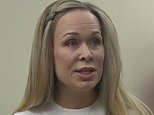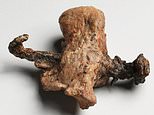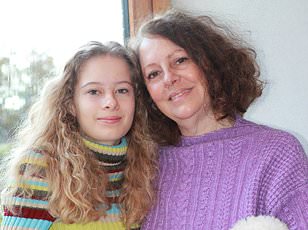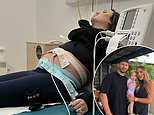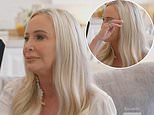I'm a GP and missed my own breast cancer symptom: Here's how to spot the early warning signs, which DON'T always include a lump
As a GP, Dr Fiona Baber felt sure she knew better than most how to recognise breast cancer symptoms.
So when in 2012 the then 49-year-old felt a strange sensation in one of her breasts, she brushed it off as nothing. ‘When you’re a GP you’re taught to examine breasts for lumps and I couldn’t feel anything, so I assumed that it was fine,’ she said. ‘But when I leaned over in the shower and pressed my fingers against my breast, I could feel one area that seemed slightly denser.’
Two months on, the sensation hadn’t disppeared. So Dr Baber, who ran a surgery in Southampton, made an appointment with another local GP. He couldn’t feel anything either – and simply told her to come back in a month if she still felt worried.
But by this point Dr Baber was desperate for an answer, so she made an appointment with a private specialist. After a series of scans and tests, her worst fears were confirmed – she had breast cancer.

Dr Fiona Baber had never even heard of the breast cancer she was diagnosed with
Despite her decades of experience, it was a type Dr Baber had never heard of: lobular breast cancer, which often does not cause lumps, the classic symptom most are aware of, making it notoriously difficult to diagnose.
Nearly 10,000 women are told they have lobular breast cancer every year in the UK, making it the second most common type. Yet little is known about it and doctors don’t know the best way to treat it. Dr Baber said: ‘I’d done years of medical training, but it just wasn’t talked about.’
Today, after a mastectomy and six months of chemotherapy, Dr Baber is in remission.
But the experience left her worried that many women were getting diagnosed far too late because they – and their GPs – did not know the warning signs. ‘I was a GP and I missed my own cancer,’ she said. ‘Think how hard it must be for the majority of women to spot the symptoms.’
Dr Baber and two other clinicians who were diagnosed with lobular breast cancer have now decided to share their stories in the hope of raising awareness of this poorly understood disease.
East Yorkshire-based GP Jane Sedcole, 66, mistook changes in her breast for the menopause and was shocked to find, after her diagnosis, that she had a form of breast cancer she’d never heard of.
And Debbie Parker, 62, was working as a nurse in London when a routine scan picked up a tiny abnormality in her breast. She had no symptoms and admits she didn’t even realise there were different types of breast cancer.
They are working with the charity Lobular Breast Cancer UK, which is calling on the NHS to educate GPs about the symptoms.
They also want changes to breast cancer screening to ensure cases of lobular are picked up quickly, as it often doesn’t show up in X-rays. ‘GPs are sending women away because they don’t know about lobular,’ said Darlaine Honey, co-founder of the charity. ‘We need a revision of the breast screening programme in this country – mammogram is not one size fits all.
‘Women are walking around thinking they’re clear when they’re not and we are missing so many cancers.’
The charity’s chair Claire Turner agrees –her breast tumour was missed on seven mammograms over three years.
‘We need to increase knowledge and understanding of lobular breast cancer among patients and healthcare professionals to get more people diagnosed quickly and effectively,’ she said.
‘Breast cancer doesn’t have to be a lump or a dimple – it can feel as minor as an inexplicable difference in tissue.’
Breast cancer kills 11,500 women in the UK every year, making it the fourth most common cause of UK cancer deaths.
Most diagnosed cases are ductal breast cancer, which occurs when abnormal cells growing in the lining of the milk ducts change and invade the surrounding tissue. Lobular disease invades cells in the breast’s lobules, the small, round sacs that make breast milk.
Unlike the ductal form, the cancer is missing a protein on the cell’s surface called E-cadherin.
Without this protein, cancerous cells don’t clump together to form a lump – instead tumours grow in strands that proliferate through the breast, like a spider’s web.
As a result, cases are often only discovered once the cancer has grown relatively large. As with other types, early diagnosis of lobular breast cancer can be the difference between life and death.
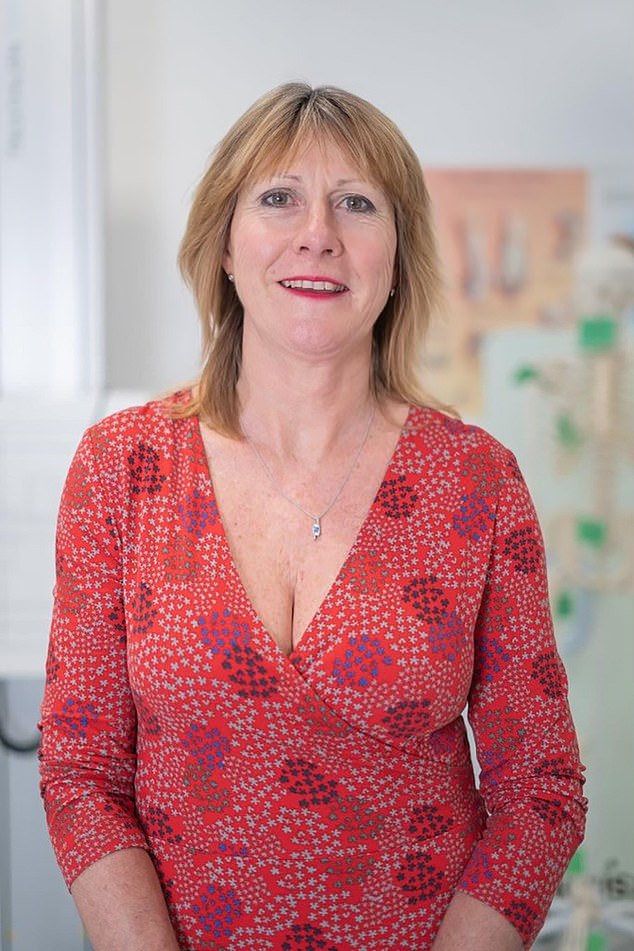
Fiona is sharing her story in the hope of raising awareness of this poorly understood disease
Research suggests that, caught early, nearly 100 per cent of lobular patients will survive five or more years.
However, if the cancer spreads outside the breasts, then this five year survival figure falls to about 20 per cent.
‘Lobular breast cancer symptoms can range from changes in the size of one breast – making it feel heavier, lumpier or thicker – to a difference in consistency of the tissue,’ said Dr Alicia Okines, a breast cancer oncologist at the Royal Marsden in London. ‘It can also cause a lump in the underarm or dimpling in skin – much like ductal breast cancer – and occasionally breast pain, though this tends to be less common.’
For BBC presenter Victoria Derbyshire, 56, the warning sign was an inverted nipple, which led her to be diagnosed with stage two invasive lobular breast cancer in 2015.
‘Women need to be more aware of symptoms that aren’t a lump,’ said Dr Okines. ‘At the moment, lobular cancers tend to be found in a more advanced stage, which requires more aggressive treatment and has a worse prognosis. But if we are able to catch cases earlier, the need for surgery and aggressive radiotherapy could be lessened.’
Experts say that a lack of obvious symptoms is not the only reason lobular breast cancer is difficult to diagnose.
The majority of ductal breast cancer cases are identified using a mammogram – an X-ray scan of the breast.
All women aged 50 to 71 are invited for a mammogram every three years to look for signs of breast cancer, as part of a national screening programme.
But research shows that lobular breast cancer does not show up on these scans due to the way the tumours form. This means that some women are wrongly assured they are tumour-free.
‘Mammograms are typically the first port of call for breast cancer diagnosis but this technique rarely works for lobular,’ said Prof Elinor Sawyer, consultant clinical oncologist at Guy’s and St Thomas’ Foundation Trust and professor of breast cancer genetics at King’s College London.
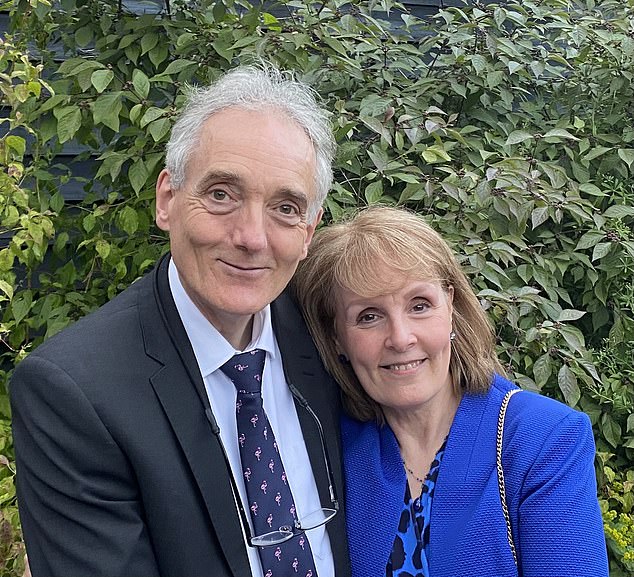
Nurse Debbie Parker with her husband Vernon
Experts say the solution lies in ensuring that women with any worrying symptoms are referred to a breast clinic and offered an ultrasound – a cheap scan regularly used on the NHS – to check for any abnormalities.
‘Doctors shouldn’t assume that because a mammogram is clear a patient is fine,’ said Ms Turner.
‘At Lobular Breast Cancer UK we hear so many stories of patients with symptoms getting clear mammograms and being told that they’re OK, then finding out that their tumours have been growing all that time.’
Experts also warn there are a lack of targeted treatments for lobular breast cancer.
This is, in part, due to the fact that, historically, there have been few clinical trials involving lobular breast cancer patients.
Experts say that, until recently, lobular and ductal breast cancer were treated as the same disease, even though there are clear differences between the two.
Not only does lobular cancer affect different parts of the breast, it is also more likely to relapse later in life than ductal cancer, and return in other areas of the body – including the brain lining and eye sockets. ‘There are no treatment guidelines specifically for lobular breast cancer because there have never been any trials looking into it,’ said
Dr Adrian Lee, director of the Precision Medicine Institute at the University of Pittsburgh in the US.
‘We need to understand the disease better, so that we can more effectively treat it.’
Nurse Debbie Parker wishes that she knew more about lobular cancer before she was diagnosed with it.
It was found during a routine scan when she was 55 – a ‘miracle’, she believes, given how difficult it usually is to find on imaging.
‘I thought there was no way it was breast cancer,’ she said.
‘I knew very well how to carry out a breast exam but I had no symptoms – no lumps, no bumps, no changes at all.’
She said it was only after a lumpectomy and radiotherapy that learning began for her and her husband Dr Vernon Parker, a London-based GP.
‘As medical professionals, we were blissfully ignorant,’ added Dr Parker. We feel in retrospect extremely lucky. It could easily have been missed and we’d be none the wiser.’
GP Jane Sedcole hopes that more awareness around the unusual symptoms of lobular breast cancer will help women to identify it before radical treatment is needed.
Jane was on holiday when she noticed a ‘difference’ in her breast five years ago, when she was 61. Although convinced it was nothing, she went to her local breast clinic to get it checked out.
‘I thought it was just menopause as I’ve always had lumpy boobs, so I was shocked when the consultant told me I had lobular,’ she said.
‘As a GP we have always worked on the theory that breast cancer isn’t always a lump, and I have diagnosed many ductal cancers in my time.
‘But when it happened to me, I felt not just shocked but stupid – I should have known.’
Jane says she was lucky to have seen a specialist, who immediately took a tissue sample from her breast – a biopsy – to check for cancer.
After a mastectomy and a course of radiotherapy, Jane was told she was cancer-free – and was grateful to avoid undergoing chemotherapy.
But having heard stories of others being turned away, she urges women to check their breasts regularly for any kind of change – and to push for further testing.
‘It’s more subtle than a lump or skin change with lobular,’ she says.
‘Mine just felt like the tissue was slightly thicker in one area.
‘So if something feels different – in any way – go and get it checked out.’
Inverted nipple that led to BBC Victoria's diagnosis

Victoria Derbyshire was diagnosed with stage 2 invasive lobular breast cancer in 2015
The first symptom of TV presenter Victoria Derbyshire’s lobular breast cancer was an inverted nipple – ‘as though something was sucking it inside the breast tissue’, she said.
Victoria, 56, left, had no clue this could be a sign of cancer and had never heard of invasive lobular carcinoma.
But after googling the symptom and going to see her GP, she was diagnosed with stage 2 invasive lobular breast cancer in 2015.
She had a right-sided mastectomy and reconstruction, followed by chemotherapy and radiotherapy.
Now she is speaking out to raise more awareness around lobular.
After revealing on I’m A Celebrity in 2020 that breast cancer doesn’t always present as a lump, she had hundreds of messages on social media from women who were inspired to get checked out.
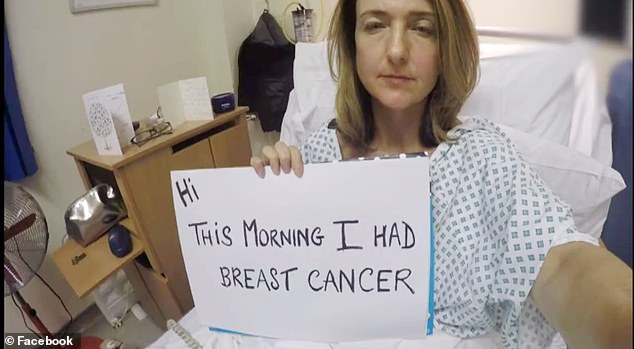
The TV presenter had a right-sided mastectomy and reconstruction
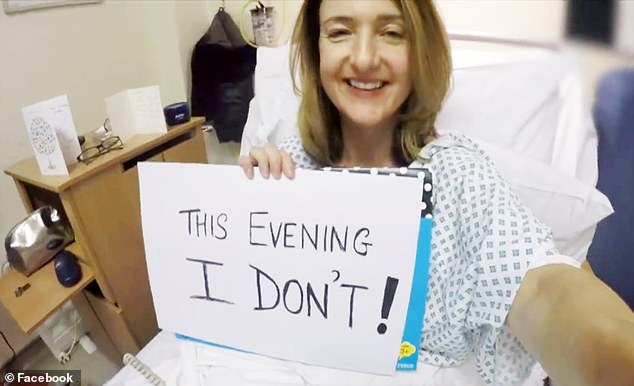
Now she is speaking out to raise more awareness around lobular
She has also discussed the peril on her podcast, And Then Came Breast Cancer – explaining to listeners that cases of lobular breast cancer ‘are still being missed because there isn’t the same focus on it in terms of money being spent, or scientific research being done’.
She added: ‘The reason I wanted to talk about what happened to me is because I’m a pretty open person.
‘But it was also because more than one in three people will be diagnosed with cancer at some point in their lifetime and here’s the thing – having cancer is manageable, it can be manageable.’










